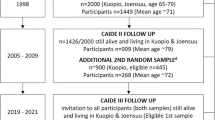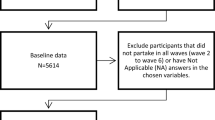Abstract
Cardiovascular risk factors increase the risk of dementia in later life. The aims of the current study were to assess the effect of multiple midlife cardiovascular risk factors on the risk of cognitive impairment in later life, and to assess the validity of the previously suggested CAIDE Study risk score predicting dementia risk 20 years later. A total of 2,165 Finnish twins were followed and at the end of the follow-up their cognitive status was assessed with a validated telephone interview. The assessment of the risk factors at baseline was based on a self-report questionnaire. Relative risk ratios (RR) were calculated and receiver operating characteristic analyses performed. Midlife obesity (RR 2.42, 95 % CI 1.47–3.98), hypertension (RR 1.38, 95 % CI 1.01–1.88) and low leisure time physical activity (RR 2.52, 95 % CI 1.10–5.76) increased the risk of cognitive impairment after a mean follow-up of 22.6 ± 2.3 years. Hypercholesterolemia did not significantly increase the risk (RR 1.52, 95 % CI 0.92–2.51). Overweight individuals who gained more than 10 % weight between 1981 and 1990 had an increased risk of cognitive impairment (RR 4.27, 95 % CI 1.62–11.2). The CAIDE Study risk score combining various individual risk factors had an area-under-curve of 0.74 (95 % CI 0.69–0.79, n = 591), and there was a strong association between an increasing risk score and the risk of cognitive impairment. The results indicate that multiple midlife cardiovascular risk factors increase the risk of cognitive impairment in later life. Also, a risk score including easily measurable midlife factors predicts an individual’s cognitive impairment risk well.



Similar content being viewed by others
Abbreviations
- AD:
-
Alzheimer’s disease
- CAIDE:
-
Finnish Cardiovascular Risk Factors, Aging and Dementia study
- MZ:
-
Monozygotic
- DZ:
-
Dizygotic
- MICF:
-
Mild impairment in cognitive function
- BMI:
-
Body mass index
- MET:
-
Metabolic equivalent
- ApoE:
-
Apolipoprotein E
- RR:
-
Relative risk ratio
- 95 % CI:
-
95 % confidence interval
- EPV:
-
Events per variable
- ROC:
-
Receiver operating characteristic
- AUC:
-
Area-under-curve
- OR:
-
Odds ratio
References
Perrin RJ, Fagan AM, Holtzman DM. Multimodal techniques for diagnosis and prognosis of Alzheimer’s disease. Nature. 2009;461:916–22.
Whitmer RA, Sidney S, Selby J, Johnston SC, Yaffe K. Midlife cardiovascular risk factors and risk of dementia in late life. Neurology. 2005;64:277–81.
Launer LJ, Ross GW, Petrovitch H, Masaki K, Foley D, White LR, et al. Midlife blood pressure and dementia: the Honolulu-Asia aging study. Neurobiol Aging. 2000;21:49–55.
Kivipelto M, Helkala E, Laakso M, Hänninen T, Hallikainen M, Alhainen K, et al. Midlife vascular risk factors and Alzheimer’s disease in later life: longitudinal, population based study. BMJ (Clinical Research Ed). 2001;322:1447–51.
Kalmijn S, Foley D, White L, Burchfiel CM, Curb JD, Petrovitch H, et al. Metabolic cardiovascular syndrome and risk of dementia in Japanese-American elderly men. The Honolulu-Asia aging study. Arterioscler Thromb Vasc Biol. 2000;20:2255–60.
Peila R, White LR, Petrovich H, Masaki K, Ross GW, Havlik RJ, et al. Joint effect of the APOE gene and midlife systolic blood pressure on late-life cognitive impairment: the Honolulu-Asia aging study. Stroke. 2001;32:2882–9.
Notkola IL, Sulkava R, Pekkanen J, Erkinjuntti T, Ehnholm C, Kivinen P, et al. Serum total cholesterol, apolipoprotein E epsilon 4 allele, and Alzheimer’s disease. Neuroepidemiology. 1998;17:14–20.
Stewart R, White LR, Xue QL, Launer LJ. Twenty-six-year change in total cholesterol levels and incident dementia: the Honolulu-Asia Aging Study. Arch Neurol. 2007;64:103–7.
Solomon A, Kareholt I, Ngandu T, Winblad B, Nissinen A, Tuomilehto J, et al. Serum cholesterol changes after midlife and late-life cognition: twenty-one-year follow-up study. Neurology. 2007;68:751–6.
Anstey KJ, Cherbuin N, Budge M, Young J. Body mass index in midlife and late-life as a risk factor for dementia: a meta-analysis of prospective studies. Obes Rev. 2011;12:e426–37.
Rovio S, Kareholt I, Helkala EL, Viitanen M, Winblad B, Tuomilehto J, et al. Leisure-time physical activity at midlife and the risk of dementia and Alzheimer’s disease. Lancet Neurol. 2005;4:705–11.
Andel R, Crowe M, Pedersen NL, Fratiglioni L, Johansson B, Gatz M. Physical exercise at midlife and risk of dementia three decades later: a population-based study of Swedish twins. J Gerontol A Biol Sci Med Sci. 2008;63:62–6.
Yamada M, Kasagi F, Sasaki H, Masunari N, Mimori Y, Suzuki G. Association between dementia and midlife risk factors: the radiation effects research foundation adult health study. J Am Geriatr Soc. 2003;51:410–4.
Rovio S, Kareholt I, Viitanen M, Winblad B, Tuomilehto J, Soininen H, et al. Work-related physical activity and the risk of dementia and Alzheimer’s disease. Int J Geriatr Psychiatry. 2007;22:874–82.
Kivipelto M, Ngandu T, Laatikainen T, Winblad B, Soininen H, Tuomilehto J. Risk score for the prediction of dementia risk in 20 years among middle aged people: a longitudinal, population-based study. Lancet Neurol. 2006;5:735–41.
Kaprio J, Sarna S, Koskenvuo M, Rantasalo I. The Finnish Twin Registry: formation and compilation, questionnaire study, zygosity determination procedures, and research program. Prog Clin Biol Res. 1978;24(Pt B):179–84.
Kaprio J, Koskenvuo M. Genetic and environmental factors in complex diseases: the older Finnish Twin Cohort. Twin Res. 2002;5:358–65.
Gatz M, Reynolds C, Nikolic J, Lowe B, Karel M, Pedersen N. An empirical test of telephone screening to identify potential dementia cases. Int Psychogeriatr. 1995;7:429–38.
Järvenpää T, Rinne JO, Räihä I, Koskenvuo M, Löppönen M, Hinkka S, et al. Characteristics of two telephone screens for cognitive impairment. Dement Geriatr Cogn Disord. 2002;13:149–55.
Järvenpää T, Rinne JO, Koskenvuo M, Räihä I, Kaprio J. Binge drinking in midlife and dementia risk. Epidemiology (Cambridge, Mass). 2005;16:766–71.
Gatz M, Reynolds CA, John R, Johansson B, Mortimer JA, Pedersen NL. Telephone screening to identify potential dementia cases in a population-based sample of older adults. Int Psychogeriatr. 2002;14:273–89.
World Health Organization. Global Database on Body Mass Index: BMI classification. 2011;2011.
Korkeila M, Kaprio J, Rissanen A, Koshenvuo M, Sorensen TI. Predictors of major weight gain in adult Finns: stress, life satisfaction and personality traits. Int J Obes Relat Metab Disord. 1998;22:949–57.
Haapanen N, Miilunpalo S, Pasanen M, Oja P, Vuori I. Agreement between questionnaire data and medical records of chronic diseases in middle-aged and elderly Finnish men and women. Am J Epidemiol. 1997;145:762–9.
Hernelahti M, Kujala UM, Kaprio J, Karjalainen J, Sarna S. Hypertension in master endurance athletes. J Hypertens. 1998;16:1573–7.
Kujala UM, Kaprio J, Sarna S, Koskenvuo M. Relationship of leisure-time physical activity and mortality: the Finnish twin cohort. JAMA. 1998;279:440–4.
Farrer LA, Cupples LA, Haines JL, Hyman B, Kukull WA, Mayeux R, et al. Effects of age, sex, and ethnicity on the association between apolipoprotein E genotype and Alzheimer disease. A meta-analysis. APOE and Alzheimer Disease Meta Analysis Consortium. JAMA. 1997;278:1349–56.
SNPedia. ApoE. 2011;2011.
Williams RL. A note on robust variance estimation for cluster-correlated data. Biometrics. 2000;56:645–6.
UCLA: Academic Technology Services, statistical consulting group. Stata FAQ: How do I use xi3?;2011.
Peduzzi P, Concato J, Kemper E, Holford TR, Feinstein AR. A simulation study of the number of events per variable in logistic regression analysis. J Clin Epidemiol. 1996;49:1373–9.
Glaziou P. Sampsize home page. 2005;2011.
Virtaa JJ, Jarvenpaa T, Heikkila K, Perola M, Koskenvuo M, Raiha I, et al. Midlife alcohol consumption and later risk of cognitive impairment: a twin follow-up study. J Alzheimers Dis. 2010;22:939–48.
Kivipelto M, Ngandu T, Fratiglioni L, Viitanen M, Kareholt I, Winblad B, et al. Obesity and vascular risk factors at midlife and the risk of dementia and Alzheimer disease. Arch Neurol. 2005;62:1556–60.
Laitala VS, Kaprio J, Koskenvuo M, Raiha I, Rinne JO, Silventoinen K. Association and causal relationship of midlife obesity and related metabolic disorders with old age cognition. Curr Alzheimer Res 2011:699–706.
Xu WL, Atti AR, Gatz M, Pedersen NL, Johansson B, Fratiglioni L. Midlife overweight and obesity increase late-life dementia risk: a population-based twin study. Neurology. 2011;76:1568–74.
Petrovitch H, White LR, Izmirilian G, Ross GW, Havlik RJ, Markesbery W, et al. Midlife blood pressure and neuritic plaques, neurofibrillary tangles, and brain weight at death: the HAAS. Honolulu-Asia aging Study. Neurobiol Aging. 2000;21:57–62.
Sparks DL, Liu H, Scheff SW, Coyne CM, Hunsaker JC III. Temporal sequence of plaque formation in the cerebral cortex of non-demented individuals. J Neuropathol Exp Neurol. 1993;52:135–42.
Gorelick PB. Status of risk factors for dementia associated with stroke. Stroke. 1997;28:459–63.
Snowdon DA, Greiner LH, Mortimer JA, Riley KP, Greiner PA, Markesbery WR. Brain infarction and the clinical expression of Alzheimer disease. The Nun Study. JAMA. 1997;277:813–7.
Esiri MM, Nagy Z, Smith MZ, Barnetson L, Smith AD. Cerebrovascular disease and threshold for dementia in the early stages of Alzheimer’s disease. Lancet. 1999;354:919–20.
Harvey J. Leptin: a multifaceted hormone in the central nervous system. Mol Neurobiol. 2003;28:245–58.
Dishman RK, Berthoud HR, Booth FW, Cotman CW, Edgerton VR, Fleshner MR, et al. Neurobiology of exercise. Obesity (Silver Spring). 2006;14:345–56.
Craft S. Insulin resistance syndrome and Alzheimer’s disease: age- and obesity-related effects on memory, amyloid, and inflammation. Neurobiol Aging. 2005;26(Suppl 1):65–9.
Kaprio J, Silventoinen K. Advanced methods in Twin studies. In: (ed), Genetic Epidemiology. New York, USA: Humana Press, c/o Springer Science + Business Media, 2011:143–152.
Lobo A, Launer LJ, Fratiglioni L, Andersen K, Di Carlo A, Breteler MM, et al. Prevalence of dementia and major subtypes in Europe: a collaborative study of population-based cohorts. Neurologic Diseases in the Elderly Research Group. Neurology. 2000;54:S4–9.
McKhann G, Drachman D, Folstein M, Katzman R, Price D, Stadlan EM. Clinical diagnosis of Alzheimer’s disease: report of the NINCDS-ADRDA Work Group under the auspices of Department of Health and Human Services Task Force on Alzheimer’s Disease. Neurology. 1984;34:939–44.
Acknowledgments
The skilful assistance of research nurses Ulla Kulmala-Gråhn, Maarit Mantere and Kristiina Saanakorpi in interviewing the subjects is gratefully acknowledged. The assistance of Maarit Lappalainen at FIMM with ApoE genotyping is acknowledged. This study was financially supported by the Academy of Finland (project #205954), the Sigrid Juselius Foundation and Clinical grants of Turku University Hospital (EVO). The Finnish Twin Cohort study is part of the Academy of Finland Center of Excellence in Complex Disease Genetics (grant #s 213506, 129680).
Conflict of interest
The authors declare that they have no conflict of interest.
Author information
Authors and Affiliations
Corresponding author
Rights and permissions
About this article
Cite this article
Virta, J.J., Heikkilä, K., Perola, M. et al. Midlife cardiovascular risk factors and late cognitive impairment. Eur J Epidemiol 28, 405–416 (2013). https://doi.org/10.1007/s10654-013-9794-y
Received:
Accepted:
Published:
Issue Date:
DOI: https://doi.org/10.1007/s10654-013-9794-y




